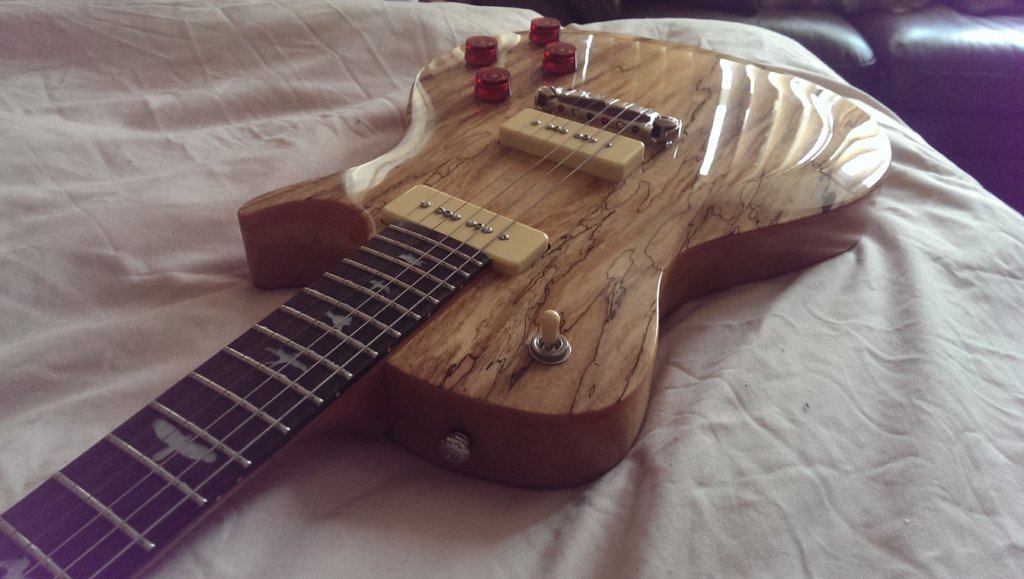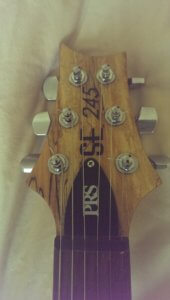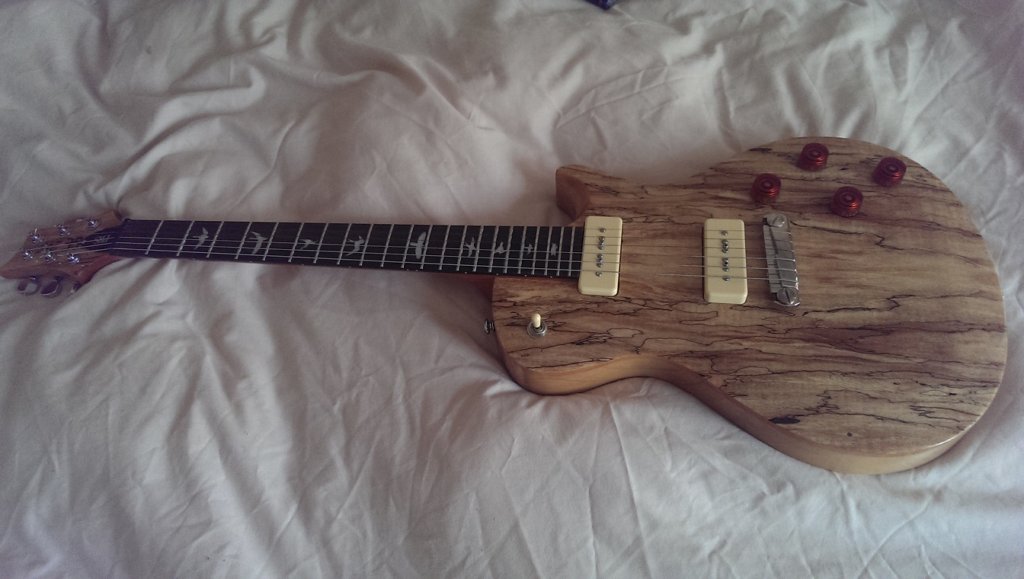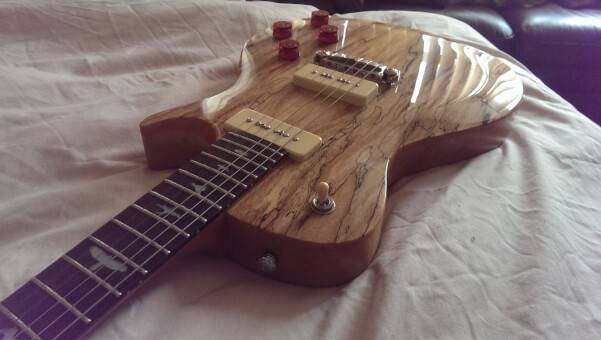Review of the Paul Reed Smith (PRS) SE 245 Limited edition Soapbar Spalted Maple electric guitar.
A modern take on a Gibson Les Paul?
My trusty Gibson Les Paul Studio had just about bitten the dust (full story here). I was after something more modern, reliable and also with a little more top end bite. The PRS core (USA) line had always appealed to me. The flawless construction and setup, modern design, tone woods and those beautiful tops. Sadly a USA PRS was way out of my price league, but their new SE Range, including the PRS SE 245, Santana SE, and Custom SE drew me into the guitar shop one day….
Test Driving of the PRS SE Range
First up was the SE 245 (with humbuckers). Too close to my Les Paul, with none of that additional ‘poke’ I was looking for, a little generic even. Next up was the Custom SE. Too sterile, more of a ‘metal’ sounding guitar and that fingerboard was just too flat and unwieldy. Not for me, but definitely the widest range of sounds. Next up was the Santana, and the best of the bunch so far. Much more classic sounding than the Custom and the single volume/tone and vibrato really appealed. Again though, it didn’t have the poke, sounding much like the SE 245.
Then the SE 245 Soapbar came into my lap. And it clicked straight away. The extra poke imparted by the PRS P90s was something I’d been missing for years with my battle worn Gibson Les Paul Studio. I was sold there and then, but unfortunately for the shop, I’d spotted a beautiful limited edition spalted maple model online, which I purchased that very night.

Standout features of the PRS SE 245 Soapbar
The first impression the £500 PRS SE 245 Soapbar gives is one of value for money. The padded gigbag is easily worth £50. Then you just have to gasp at the sheer beauty of the thing. Spalted maple with cream P90s is a good look any day of the week, but add to that the classic PRS bird inlays, the minimalist wrap-over one piece bridge and the matching spalted maple headstock veneer, and you have one of the best looking instruments I’ve ever laid my eyes on.
After the initial visual impact, you begin to appreciate the finer details that PRS have considered in the design, No unnecessary scratch plates, pickup surrounds or selector switch ring. Oversized strap-buttons meaning you don’t need to worry about straplocks. Straight string pull over the nut (an improvement on Gibson’s design). The PRS S245 Soapbar also features a 24.5 inch scale length, meaning looser string tension and easier playability.
With regards to the general construction, it’s a tried and tested, reassuringly thick single cut design, but sleeker than a Gibson Les Paul. It seems trimmed down with better upper-fret access. It’s lighter too, even taking into account the neck and fingerboard which is a very deep C, almost a D profile with a “Wide/flat” fingerboard. It takes some getting used to.

Sounds of the PRS SE 245 Soapbar
P90’s on a mahogany-bodied guitar is match made in heaven. You get all warmth of the body plus the unruly, snappy grunt of the P90’s. In the bridge position there’s more clarity than a humbucker but more warmth and power than a traditional single coil, which means you can cover a lot of ground between the two extremes. Some would say this is the best of both worlds as the guitar takes on a chameleon-like character with an answer to anything you throw at it. A memorable tone that stays with me is the almost tele-like woody bark on the wound strings.
Of course the P90 is also a common neck pickup replacement in Les Pauls, and for good reason. The Gibson Les Paul neck humbucker just isn’t versatile enough, especially with gain. It’s too warm, too mushy and indistinct. Here though we have all the clarity you could want, but it still contrasts starkly with the bridge. It’s full and plummy but still versatile and usable. I found myself switching over to the neck more often than I did with my Les Paul.
In the middle you’ll get more snap than a humbucker, which is welcome for funk etc, but if you’re focused on this choppy/syncopated style nothing really compares to the out-of-phase positions on a Fender Stratocaster.
The on-piece bridge, light weight and general stripped down, unhindered design seems to impart a natural resonance to the guitar. It’s just a great, natural-sounding, classic-voiced, versatile instrument.
Problems with the PRS SE 245 Soapbar
Sadly, the PRS SE 245 Soapbar has a number of issues, most obvious of which are the electrics. Playing with moderate gain, (classic rock/blues nothing excessive) if you even so much as nudge those volume pots, you’ll immediately lose all your top-end. It’s more of an on-off switch than a taper. This is a deal-breaker for me as I like to set up a lead tone and back off the volume for rhythm, which the PRS SE245 makes impossible.
Next up is the nut, which is obviously cut for 9’s even though the guitar ships with 10’s. With it’s 24.5 inch scale 9’s are out the question, the action is just too floppy, yet if you install anything heavier the strings will bind in the nut, causing all sorts of tuning issues.
New electrics and new nut needed then…..
Its true the P90s are versatile, but another way of looking at it is that they’re a compromise. You’ll never get the cleans of a strat or the singing sustain of a Gibson Les Paul. I can live without the cleans but when applying gain and going for the big solo bends, P90s just don’t sing as well as humbuckers, the notes tend to die out sooner, just when you don’t want them to.
A small thing to many, but what really got my goat with my particular SE 245 Soapbar was the so-called ‘mahogany’ body. It didn’t look much like mahogany to me, in fact, as you can see from the picture below, it was even lighter in colour than the top! Compared back to back with my Les Paul confirmed it was a totally different wood. I even sent an email to Thomann complaining about this. They confirmed it was mahogany. Oh well.

Conclusions
Well, it wouldn’t stay in tune (because of a poorly cut nut) and I couldn’t use the volume controls live (because of the inferior electrics).
On top of this, the PRS SE 245, for all the hype about legendary PRS playability and quality control etc, just wasn’t set up as well as my battle-scared 10 year old Gibson Les Paul Studio. I could get the action much lower on that, and the neck was far less of a handful.
In fact looking back, the PRS SE 245 doesn’t seem like that much of a bargain anyway, for £500 I got a product made in Korea, with inferior woods, electronics and setup, and a soft case. My USA made Gibson Les Paul Studio was only £799, and came with it’s own hard case, nitro-cellulose, a pro-setup and fully working electrics that never let me down once. Plus it has a proper dark mahogany back.
Nevertheless, PRS got VERY close to the mark with the SE 245 soapbar. The sounds are there, and it’s a beautiful looking and intelligently designed instrument, I just with they’d spent a little more on the electronics and quality control.

Leave a Reply